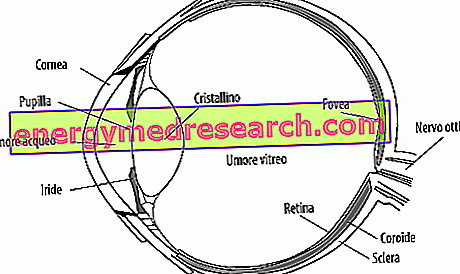What is the Cornea
The cornea is the membrane that covers the front of the eye, through which it is possible to see the iris and the pupil.
Transparent and avascular, this structure represents the first "lens" that light meets on its way to the brain. The cornea is, in fact, an essential element of the ocular dioptric system: it allows the passage of light rays towards the internal structures of the eye and helps to focus images on the retina.
The cornea is made up of overlapping layers, the outermost of which is the stratified paved epithelium, while the successive ones are formed by a dense weave of collagen fibrils arranged in lamellae, with a glycoprotein matrix that unites them and makes them transparent.

Appearance and structure
The cornea constitutes the anterior portion of the fibrous tunic of the eyeball. The sclera - that is the "white part of the eye" with which the corneal surface is structurally in continuity - represents, instead, the five posterior sixths of the same cassock.
The outer surface of the cornea is convex and has a slightly elliptical shape, with the horizontal diameter larger than the vertical one. The inner face is, instead, concave and has roughly the same radius of curvature as the front part (the front curvature radius is equal to 7.2 mm, while the rear one is 6.8 mm). The cornea is thinner in the central area (about 520-540µm) than the periphery (about 0.7-0.8 mm).
From the structural point of view, in the cornea there are five layers (from the outside towards the inside):
- Corneal epithelium : multi-layered paved type, it is often 50-60 µm (about a tenth of the total thickness of the cornea). Arranged in 5-6 layers there are basically three types of cells: basal, polygonal (intermediate) and flat surface, which represent different maturation stages of the same cellular unit. These elements, with an optically perfect shape, are joined together by tight joints. Basal cells have high replicative activity, protect the ocular surface from mechanical abrasion and form a permeable barrier.
- Bowman's plate (or anterior limiting membrane): located under the corneal epithelium, it is a cell-free membrane made up of a weave of collagen fibers, immersed in a proteoglycan matrix (thickness: 10-12 µm).
- Corneal stroma : it constitutes most of the total thickness of the cornea (400-500 µm); it is mainly composed of connective fibers, glycoprotein matrix and keratocytes. In the stroma, type I collagen fibrils are organized in different lamellar layers, distancing themselves from each other with extreme precision. Keratocytes combine to form a sort of network between a lamellar layer and the next. The precise three-dimensional arrangement of the fibers and corneal cells, together with the identical index of refraction of the matrix interposed between the stromal lamellae, are responsible for the perfect transparency of the cornea.
- Descemet's membrane (or posterior limiting membrane): like the Bowman's lamina, this layer is acellular and formed by a thin lattice of collagen fibers, radially available; it has a variable thickness of 4-12 µm (it tends to thicken in proportion to age).
- Endothelium : it is the deepest layer of the cornea, consisting of a single layer of flattened cells of hexagonal shape, rich in mitochondria, connected by desmosomes and intercellular densities. The endothelium plays an important role in regulating the exchanges between the aqueous humor and the upper layers of the cornea; moreover, it maintains the trophism and corneal transparency.
Layer of Dua
In 2013, during a scientific research that aimed to clarify some aspects about the outcome of corneal transplants, a sixth corneal layer was identified, called "layer of Dua".
Located in the posterior part of the cornea, between the stroma and Descemet's membrane, the Dua layer has a thickness of only 15µm. This can be highlighted only by examination by electron microscope, after insufflation of tiny air bubbles, which gently induce the separation of the different layers that make up the cornea.
Despite the very thin thickness, the Dua layer is extraordinarily resistant (it can withstand pressure values of 1.5-2 bar). According to the authors of the study, if surgeons were able to inject a bubble near the layer of Dua, the risk of secondary lesions to the corneal transplant could be reduced, thanks to the high degree of resistance of which this membrane is endowed. Furthermore, the results of this research can help to understand numerous corneal pathologies, including acute hydrops, descemetocele and pre-Descemet dystrophies.
Relationships with other eye structures
The anterior surface of the cornea, convex and directly related to the external environment, is covered by the tear film. The bulbar conjunctiva stops, in fact, at the level of the sclero-corneal junction.
The cornea continues posteriorly with the sclera, with respect to which it differs in curvature, structure and functions.
The posterior, concave corneal surface delimits the anterior chamber of the eye, therefore it is bathed by the aqueous humor. When the eye is closed, the cornea comes into contact with the palpebral conjunctiva.
Vascularization
The cornea must be totally transparent to allow the correct passage of light towards the internal structures of the eye. For this reason, it is devoid of blood vessels.
The superficial cells of the epithelium draw oxygen and nourishment from the tear film and from the vascular loops of the sclerocorneal limbus.
As for the cells of the stroma and endothelium, located more deeply, instead, the gases and nutrients come from the aqueous humor (which fills the anterior chamber), from the limbal vessels and from the branches of the anterior ciliary arteries.
innervation
At the corneal level, there are numerous nerve endings, which make this surface one of the most sensitive portions of the entire eyeball. This aspect is particularly significant, considering that a corneal lesion can cause blindness, even if the other parts of the eye are perfectly normal.
The innervation of the cornea is of the sensory type and represented by the ends of long ciliary nerves of the naso-ciliar branch of the trigeminal ophthalmic branch.
The rich trigeminal innervation makes the corneal surface extremely sensitive to stimuli of various nature (tactile, thermal and pressure). This sensitivity is reduced in old age and in some inflammatory and dystrophic-degenerative alterations.
Functions
The cornea has three important functions:
- Protection and support of eye structures;
- Filtration of some ultraviolet wavelengths: the cornea allows light rays to pass through the tissue without being absorbed or reflected on its surface;
- Light refraction: the cornea is responsible for 65-75% of the eye's ability to converge the light rays coming from an external object on the fovea (central region of the retina).
In the vision process, the cornea is one of the most important dioptric means of the eye. The corneal surface behaves like a converging lens of about 43 diopters and is able, together with the crystalline lens (whose average dioptric power is about 18-20 diopters), to convey the light rays towards the retina, so that the perceived image is clear.
The optic function of the cornea is carried out thanks to its perfect transparency (made possible by the avascularity, by the structural characteristics of the stroma and by physiological mechanisms that ensure the water exchange and prevent its imbibition) and the regularity of the contact surface with the air.
Other physiological characteristics of the cornea are the specularity, linked to epithelial integrity, and permeability, an essential function for water exchange and drug penetration.
NOTE . The dioptric power of the anterior corneal surface (convex) is +48 diopters, while that of the inner face (concave) is equal to -5 diopters.
Corneal diseases
There are many diseases that affect the cornea by altering their shape, thickness and transparency.
Among the conditions capable of compromising the corneal function are traumatic, chemical and infectious diseases.
Furthermore, the cornea may be subject to non-infectious inflammations, ulcerations and congenital alterations of its curvature. The symptoms that suggest corneal involvement include pain, particularly with exposure to light, and decreased vision.
The most common corneal disorders are the following:
- Keratoconus : degenerative disease that causes the progressive distortion of the corneal surface. The cornea, normally round, becomes thinner and begins to vary its curvature protruding outwards and assuming a cone-shaped appearance. Keratoconus does not allow the correct passage of light towards the internal ocular structures and modifies the refractive power of the cornea, causing a loss of visual acuity.
- Corneal abrasion : superficial damage caused by contact with dust, sand, wood chips, metal particles or other materials that can scratch or cut the cornea. In the case of corneal abrasion, you may experience a gritty sensation in the eye and a corneal pain with increased tearing, conjunctival redness, photophobia, visual blurring and headache.
- Corneal ulcer: severe corneal injury that usually results from an inflammatory or infectious process, but can also be caused by mechanical trauma (penetration of foreign bodies or abrasions of the ocular surface), chemical damage, eyelid anomalies (eg chronic blepharitis, entropion and trichiasis), severe allergic reactions or nutritional deficiencies (in particular: protein malnutrition and vitamin A deficiency). The corneal ulcer is similar to an open wound and is characterized by the interruption of the epithelial layer (superficial), with involvement of the stroma and underlying inflammation. The symptoms depend on the causes, the size and the depth of the lesion. Treatment must be immediate to prevent complications and permanent damage.
- Keratitis : inflammation of the cornea, more or less deep, caused by various factors, such as infections (viruses, bacteria, protozoa, fungi), physical agents (eg ultraviolet rays) or systemic diseases (rheumatoid arthritis or disseminated vasculitis). The keratitis can manifest itself with small superficial erosions (mini sinkings of the epithelium), opacities disseminated inside the cornea (stromal infiltrates), vision loss, pain and light intolerance (photophobia). Once healed, it can only in some cases leave permanent micro-cracks.
- Corneal edema: presence of an excess of watery content inside the cornea.
- Corneal dystrophy : heterogeneous group of non-inflammatory genetic diseases affecting the cornea; they are characterized by the formation of opacity which causes a variable visual deficit.
- Corneal neovascularization : vascular invasion of the cornea due to excessive growth of blood vessels starting from the limbus (area between stroma and sclera-conjunctiva); the process may be secondary to the migration of surrounding epithelial cells and oxygen deprivation. The growth of blood vessels within the corneal tissue can lead to opacification and reduced vision.



